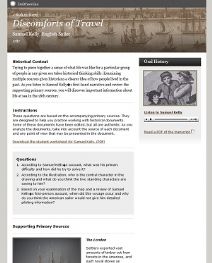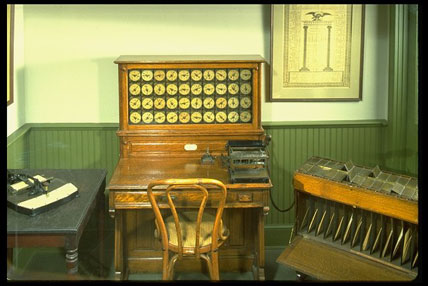As COVID-19 deaths spiked in 2020, Suzanne Firstenberg’s public art installation "In America: How could this happen…"
History Explorer Results (8)
Related Books (1)

Grade Range:
8-12
Resource Type(s):
Reference Materials
Date Posted:
9/4/2020
“Like many other churches in the early republic, the Congregational meetinghouse in Castine, Maine, served both sacred and secular functions. Built in 1790, it was home not just to worship services but town meetings and judicial proceedings. Taxpayers paid its pastor’s wages. Though the ratifica

Grade Range:
6-12
Resource Type(s):
Primary Sources, Interactives & Media, Lessons & Activities, Worksheets
Duration:
11 minutes
Date Posted:
4/2/2012
Samuel Kelly was an English sailor, who recorded his experience of a voyage to Philadelphia in 1787. Listen to a dramatic reading of his narrative, and then study the supporting primary sources to answer the discussion questions. This resource is part of a series called “Life at Sea: 1680

Grade Range:
K-12
Resource Type(s):
Artifacts, Primary Sources
Date Posted:
3/23/2012
This is a set of eight "dropping sticks" used to teach acoustics. It was made in Paris by the famous scientific instrument maker Rudolph Koenig, sometime between 1858 and 1902. This particular set was used in the introductory physics class of the Worcester Polytechnic Institute.
These s

Grade Range:
9-12
Resource Type(s):
Interactives & Media
Duration:
5 minutes
Date Posted:
5/26/2010
Newsreel video footage from 1944 and 1945, showing the Allies prepare and carry out the invasion of Normandy, the liberation of Paris, Battle of the Bulge and the eventual fall of the Third Reich and surrender of Germany.
This video is part of the Price of Freedom learning resources packag

Grade Range:
K-12
Resource Type(s):
Artifacts, Primary Sources
Date Posted:
3/10/2009
Samuel F. B. Morse (1791-1872), an artist and inventor of the telegraph, was in Paris in 1839 sharing the scientific and celebrity stage with Daguerre. The two inventors shared notes on their inventions and Morse returned to the US with a camera, perhaps the first camera in the United States...

Grade Range:
K-12
Resource Type(s):
Artifacts, Primary Sources
Date Posted:
3/10/2009
Believed to be the first photographic portrait made in the United States, this portrait of Dorothy Catherine Draper was originally taken by her brother Dr. John W. Draper (1811-1882) in his Washington Square studio at the New York University in 1839 or 1840, within the first year of Louis Jacques

Grade Range:
K-12
Resource Type(s):
Artifacts, Primary Sources
Date Posted:
3/9/2009
During the 1880s, the engineer Herman Hollerith devised a set of machines for compiling data from the United States Census. Hollerith's tabulating system included a punch for entering data about each person onto a blank card, a tabulator for reading the cards and summing up information, and a sor

Grade Range:
4-12
Resource Type(s):
Reviewed Websites
Date Posted:
9/18/2008
This website is an invaluable resource for teachers and students who are interested in locating, reading and researching important primary source documents in their entirety. The Avalon Project is committed to digitizing important documents relevant to the fields of Law, History, Economics, Polit










